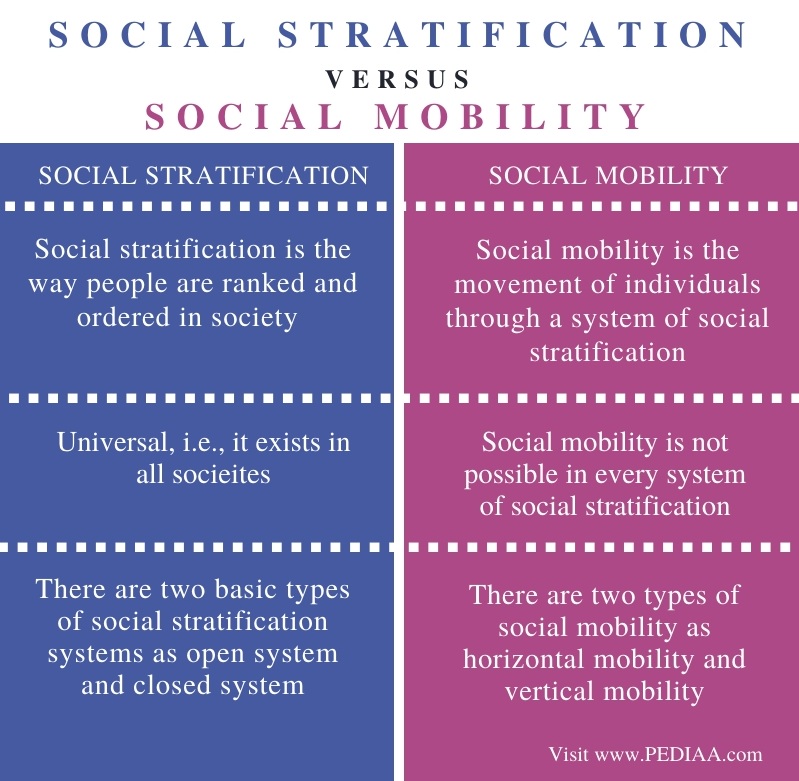Identify and Describe the Three Types of Social Mobility
The three types of social mobility are intergenerational structural and exchange mobility. According to the direction of transition there are two types of vertical social mobility ascending and descending or social climbing and social sinking.

What Is The Difference Between Social Stratification And Social Mobility Pediaa Com
Wealth is the most significant way of distinguishing classes because wealth can be.

. This results in changes in the membership of the upper middle and lower class over time. In contrast individuals experience downward mobility when they move from higher socioeconomic class to a lower one. There has scarcely been any society whose strata were absolutely closed or in which vertical mobility in its three forms.
Closed societies are caste ridden as in India and the status of a person is determined by his being born in a particular caste. Identify and describe the three types of social mobility. Status differences between generations in the same family.
Social mobility describes a shift from one social class to another. Vertical mobility is what we typically think of when we think of social mobility. This refers to a change in the occupational political or religious status of a.
This type of mobility can be either upward or downward depending on whether the person moves to a higher or lower position in the stratification system. - In the chapter 7 there are two different types of social mobility that came from the system of stratification. Identify intergenerational mobility and intergenerational mobility and give an example to illustrate them.
There are three main classes in the United States. Individuals can experience upward or downward social mobility for a variety of reasons. This is the movement between social classes.
The relation of a master and slave was the peak of inequality in human history. Movement between social classes or strata. Social stratification defines the hierarchical structures of class and status in a society.
Stratification systems which provide little opportunity for social mobility is termed as closed caste system whereas that with a relatively high rate of social mobility as open class system. First there is horizontal mobility. Identify the three types of social mobility and distinguish the differences between them.
Identify and describe the three types of social mobility. Within each class there are many subcategories. Movement between social classes or strata.
It has many dimensions viz direction time and place etc. According to Kendall 2015 the intergenerational mobility is the social movement experienced by family members from one generation to the next whereas the. Sociologists have identified several types of social mobility.
This is the movement within a social class. Move up and down at the same rate maintaining balance in social class. Movement up or down based on changes in structure of society than action of individualsmake opportunities arise Exchange mobility.
An example of this is when an individual moves from one job to another of equal social ranking. Identify 3 types of social mobility explain how these 3 types of social mobility differ include 3 examples Vertical mobility is the movement between social classes or strata. Ascending and descending or social climbing and social sinking Sorokin 1.
An example of vertical mobility would be the. Next there is vertical mobility. There are two types of vertical mobility.
Upward mobility refers to an increaseor upward shiftwhen they move from a lower to a higher socioeconomical class. Intergenerational mobility is the change that family members make in social class from one generation to the next. Movement within a social class or stratum.
Low social mobility implies that nothing changes such that rich families stay rich and poor families stay poor. This occurs when a person or group of people moves up or down in social. Movement down social ladder Structural mobility.
Direction of transition there are two types of vertical social mobility. This occurs when a person changes their occupation but their overall social standing remains. Class traits also called class markers are the typical behaviors customs and norms that define each class.
Movement within a social class or stratum. Economic political and occupationalwas not present. Vertical horizontal and lateral mobility.
Sociologists generally identify three levels of class in the United States. It forms the larger power structure that influences all the social activities within that particular community. Social mobility can be studied from many angles.
Horizontal social mobility Vertical social mobility Intergenerational mobility Intra-generational mobility Occupational Mobility. Some people move downward because of. Recognize characteristics that define and identify class.
The societies of the world can be divided into two groups closed societies and open societies. Social mobility is the degree to which it is possible to change your social and economic status within a society based on your efforts or lack of efforts. There has never existed a society in which vertical social.
Types of Social Mobility. Movement up social class ladder Downward social mobility. Describe several types of social mobility.
Types of Social Mobility 1. Upper middle and lower class. Upper middle and lower class.
Social structure of society influences the social mobility.

Social Mobility Boundless Sociology


Comments
Post a Comment